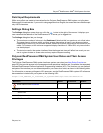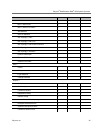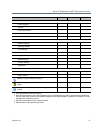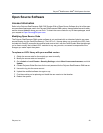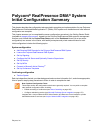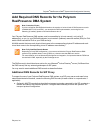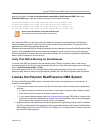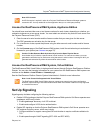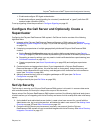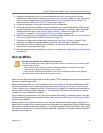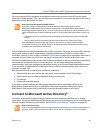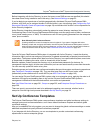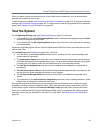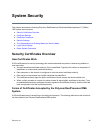
Polycom
®
RealPresence DMA
®
System Initial Configuration Summary
Polycom, Inc. 32
specify is the one in the Call server sub-domain controlled by RealPresence DMA field on the
Embedded DNS page. Here are example records for two two-server clusters:
callservers.example.com. 86400 IN NS dma-asia-server1.example.com.
callservers.example.com. 86400 IN NS dma-asia-server2.example.com.
callservers.example.com. 86400 IN NS dma-europe-server1.example.com.
callservers.example.com. 86400 IN NS dma-europe-server2.example.com.
Your enterprise DNS must also have the zone callservers.example.com defined and be configured to
forward requests for names in that zone to any of the clusters in the supercluster. The way you do this
depends on the DNS server software being used.
Queries to the enterprise DNS for callservers.example.com are referred to the specified RealPresence DMA
clusters. Their embedded DNS servers create and manage A records for each site in the site topology.
When responsibility for a site moves from one cluster to another, the A records are updated so that the site’s
domain name is mapped to the new cluster.
Verify That DNS Is Working for All Addresses
To confirm that DNS can resolve all the host names and/or FQDNs, ping each of them, either from a
command prompt on the PC you’re using to access the system or from one of the clusters you’re setting up
(go to Troubleshooting Utilities > Ping).
If you have access to a Linux PC and are familiar with the dig command, you can use it to query the
enterprise DNS server to verify that all the records (A/AAAA, NS, and SRV) are present and look correct.
License the Polycom RealPresence DMA System
A Polycom RealPresence DMA system is licensed at the cluster level (single-server or two-server). A
cluster’s license specifies:
● The maximum number of concurrent calls that can touch the cluster. In a supercluster configuration,
note that:
A single call may touch more than one cluster. It consumes a license on each cluster it touches.
Each cluster may be licensed for a different number of calls.
If your superclustering strategy (see About Superclustering on page 226) calls for a cluster to be
primary for one territory and backup for another, it must be licensed for the call volume expected
when it has to take over the territory for which it’s the backup.
● Whether access to the RealPresence
®
Platform Application Programming Interface (API) is enabled.
The API provides an API client application with programmatic access to the Polycom RealPresence
DMA system (see RealPresence
®
Platform API on page 16). In a supercluster, all clusters must have
the same API licensing status.
Note: Virtual Host Names Cannot Have NS Records
NS records for the virtual host names must not exist.



